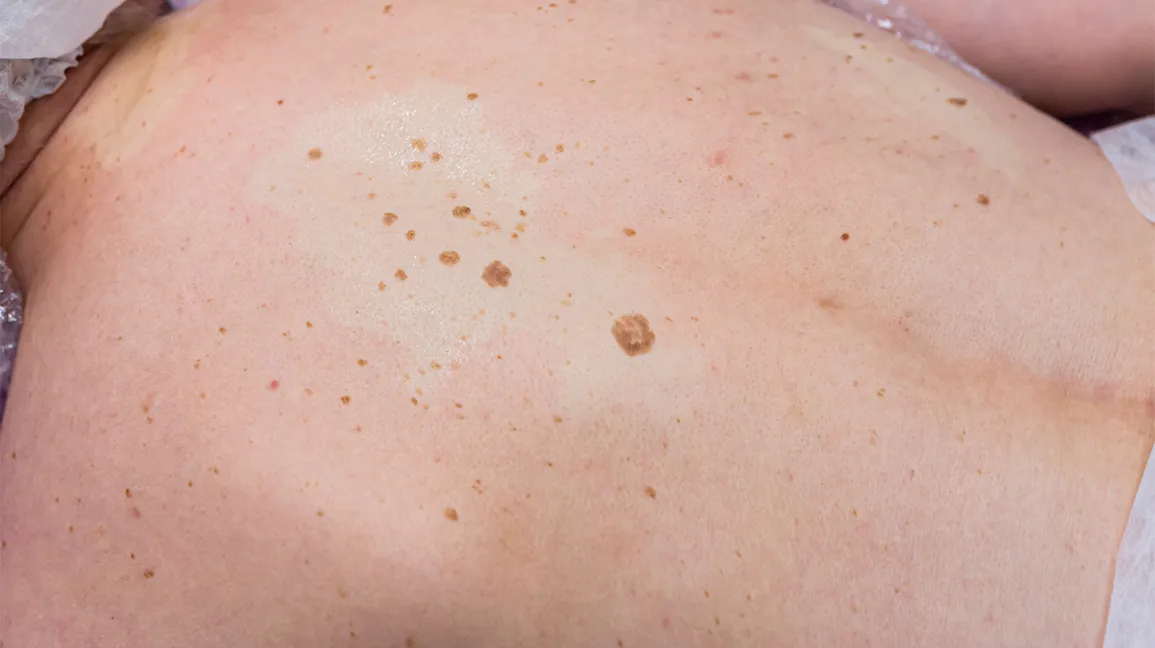
The skin is made up of two main layers and various kinds of cells. The outer layer of the skin is called the epidermis.
The inner layer of the skin is called the dermis. This layer is thicker and contains blood vessels, nerves, and sweat glands. Hair (value) on the skin also grows in tiny pockets in the dermis called follicles. The dermis produces sweat, which helps cool the body, and oils that keep the skin from drying out.
Skin cancer is more common among people whose skin is fairer and who have spent much time in the sun. Skin cancer can occur anywhere on the body, but it is most common in areas with the most exposure to sunlight, such as the face, neck, hands, and arms.
If the person has a spot or bumps on the skin, the doctor may remove it to look at the tissue under a microscope. This procedure is known as a biopsy. The biopsy can usually be done in a doctor’s office. Before the biopsy, a local anaesthetic is given to numb the area for a short time.
Types of skin cancer
Once skin cancer is found, more tests will need to be done to find out if cancer has spread. This procedure is called staging. The doctor needs to know the stage and type of skin cancer to plan the proper treatment. The following steps are used for treatment classification.
Squamous cell carcinoma (squamous cell carcinoma)
Squamous cell tumours also occur on skin areas exposed to the sun, often on the upper nose, forehead, lower lip, and hands. They can also appear on areas of the skin that have been burned, exposed to chemicals or radiation therapy. This cancer usually appears as a complex, reddish lump. Sometimes the tumour may have a scaly appearance or bleed or crust over.
actinic keratoses
Actinic keratosis is a non-cancerous skin disorder that can develop into a basal or squamous cell cancer in some people. It appears on the skin as red or brown, rough, scaly patches, usually on areas exposed to the sun.
Skin cancer treatment
There are treatments for all patients with skin cancer. Three kinds of treatments are used:
surgery (removal of cancer)
chemotherapy (use of drugs to kill cancer cells)
radiation therapy (using x-rays to kill cancer cells)
Many skin cancers are treated by doctors specialising in skin diseases (dermatologists, plastic surgeons). Cancer can usually be treated in a doctor’s office.
Surgery is the most common treatment for skin cancer. Your doctor may remove cancer using one of the following methods:
Electrodesiccation and curettage. An operation in which an electric current is used to dehydrate the tumour (electrodesiccation), and then a specialised instrument called a curette is used to remove cancer.
Cryosurgery. Operation in which the tumour is frozen and destroyed.
Simple excision. An operation in which the skin cancer is removed along with some of the healthy tissue around it.
Surgery can leave a scar on the skin. Depending on the size of the cancer, the skin may be taken from another part of the body to put on the area where the tumour was removed. This procedure is called a skin graft. There are new surgical methods or grafts through which scars can be reduced.
Radiation therapy uses x-rays to kill cancer cells and shrink tumours. Radiation therapy for skin cancer comes from a machine outside the body (external radiation therapy).
Chemotherapy consists of the use of drugs to kill cancer cells. Chemotherapy treatment is often given as a cream or lotion applied to the skin to kill cancer cells (topical chemotherapy). Chemotherapy can also be in pill form or put into the body through a needle into a vein or muscle.
Basal Cell Carcinoma Treatment
The patient could receive any of the following treatments:
Micrographic surgery. Where cancer and as little normal tissue as possible are removed. During the process, the doctor removes the tumour and then uses a microscope to examine the surgery area to ensure no cancer cells are left.
Surgery in which the skin cancer and some of the surrounding healthy tissue are removed.
Electrodesiccation and curettage. An operation in which an electric current is used to dehydrate the tumour (electrodesiccation), and then a specialised instrument called a curette is used to remove cancer.
Cryosurgery. Surgery involves freezing and killing cancer.
- Radiotherapy.
- Topical chemotherapy.
- Chemoprevention clinical trials.
- Clinical trials of biological therapy.
- Photodynamic therapy is a technique in which photosensitive drugs are used to eliminate cancer.
It is crucial to check your skin regularly so cancer can be treated if it comes back (recurs).

